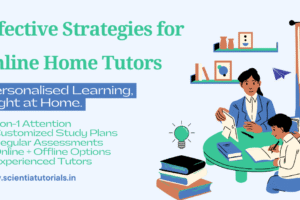Engaging Minds: Incorporating Fun and Interactive Learning in Home Tutoring
Introduction
Home tutoring is a powerful tool for academic success, but it often risks becoming monotonous if not approached with creativity and enthusiasm. One of the most effective ways to enhance learning outcomes is by incorporating fun and interactive elements into the tutoring sessions. This article explores practical strategies for home tutors to create an engaging and dynamic learning environment that not only makes the sessions enjoyable but also maximizes student retention and understanding.
Understanding the Importance of Fun in Learning
The Psychological Impact of Fun
Research shows that students are more likely to engage and retain information when they enjoy the learning process. Fun learning experiences stimulate curiosity, boost motivation, and reduce anxiety, allowing students to explore new concepts freely. When students associate learning with enjoyment, they develop a more positive attitude towards education overall.
The Role of Interaction
Interactive learning techniques encourage active participation from students, fostering collaboration, critical thinking, and problem-solving skills. By making learning interactive, tutors can help students connect theoretical knowledge with practical applications, making the material more relevant and easier to grasp.
Strategies for Incorporating Fun and Interactive Learning
1. Gamify Learning
Creating Educational Games
Transform traditional lessons into games that promote friendly competition. Whether it’s through quizzes, board games, or digital platforms, gamification encourages students to engage with the material while having fun. For example, create a trivia game related to the subject matter, allowing students to earn points for correct answers.
Using Apps and Online Resources
Leverage technology by using educational apps that gamify learning. Platforms like Kahoot! and Quizlet allow tutors to create interactive quizzes and flashcards, making learning both enjoyable and effective.
2. Utilize Hands-On Activities
Experimentation and Exploration
Incorporate hands-on activities that require students to explore concepts actively. For science subjects, simple experiments can demonstrate principles in a tangible way. For example, if tutoring chemistry, you might conduct safe experiments that illustrate reactions.
Arts and Crafts
For younger students, incorporating arts and crafts can enhance understanding of various subjects. For example, creating a poster about a historical event can help reinforce key concepts while allowing students to express their creativity.
3. Foster Collaborative Learning
Group Projects
Encourage collaborative projects where students work together to solve problems or create presentations. This fosters teamwork and communication skills while making learning more enjoyable.
Peer Teaching
Allow students to take turns teaching each other specific topics. This peer teaching strategy reinforces their understanding of the material and builds confidence.
4. Incorporate Technology
Interactive Tools
Use technology to make lessons more interactive. Tools like interactive whiteboards and tablets allow students to participate actively in lessons. For example, using educational videos, simulations, or interactive websites can break the monotony of traditional teaching methods.
Virtual Field Trips
Leverage virtual field trips to explore subjects beyond the confines of home. Many museums, zoos, and educational platforms offer virtual tours, allowing students to learn about various topics in an engaging manner.
5. Encourage Creative Expression
Role-Playing and Simulations
Introduce role-playing or simulation activities that allow students to immerse themselves in real-world scenarios. For instance, if teaching history, students can act out historical figures or events, making the content more relatable and memorable.
Creative Writing and Storytelling
Encourage students to express their understanding of topics through creative writing or storytelling. This can include writing short stories, poems, or even scripts related to the subject matter.
6. Use Real-World Connections
Contextual Learning
Make learning relevant by connecting it to real-world situations. For example, in a math lesson, discuss budgeting or finance to help students understand the practical applications of mathematical concepts.
Guest Speakers
Invite guest speakers who can share their expertise and experiences related to the subject being taught. This not only adds an interactive element but also exposes students to different perspectives and career paths.
7. Incorporate Movement
Active Learning Techniques
Incorporate movement into your lessons to keep students engaged. Activities like “gallery walks” where students move around to different stations to complete tasks can be highly effective.
Learning Stations
Set up learning stations where students can rotate through various activities related to the lesson. This dynamic approach allows for a change of scenery and keeps energy levels high.
Creating a Positive Learning Environment
Building Rapport
Establishing a positive relationship with students is crucial for fostering engagement. Be approachable, listen to their concerns, and create a safe space for open dialogue. This rapport encourages students to express themselves freely and actively participate in the learning process.
Recognizing Achievements
Celebrate student achievements, no matter how small. Positive reinforcement boosts confidence and motivates students to continue putting in effort. Use praise, rewards, or even a simple acknowledgment to recognize their hard work.
Tailoring to Individual Needs
Understanding Different Learning Styles
Every student learns differently. Some may thrive in hands-on activities, while others may prefer visual or auditory methods. Assess each student’s learning style and tailor your interactive strategies accordingly.
Personalizing the Experience
Incorporate students’ interests into lessons. For example, if a student loves sports, use sports-related examples in math problems or history discussions. This personalization makes the learning experience more relevant and enjoyable.
Continuous Improvement and Adaptation
Seeking Feedback
Regularly seek feedback from your students about what they enjoy and what could be improved. This insight allows you to adapt your teaching methods to better suit their preferences and needs.
Staying Updated on Trends
Stay informed about new educational trends and resources that promote fun and interactive learning. Attend workshops, join teaching communities, and explore educational blogs to discover fresh ideas and techniques.
Conclusion
Incorporating fun and interactive learning techniques into home tutoring sessions is essential for keeping students engaged and motivated. By implementing strategies such as gamification, hands-on activities, technology integration, and real-world connections, home tutors can create a dynamic learning environment that enhances student understanding and retention.
Remember, the goal is to foster a love for learning that extends beyond the tutoring sessions. By making education enjoyable and interactive, you empower your students to become lifelong learners, equipped with the skills and motivation they need to succeed academically and in their future endeavors. Embrace creativity, adaptability, and enthusiasm in your teaching, and watch your students flourish!



